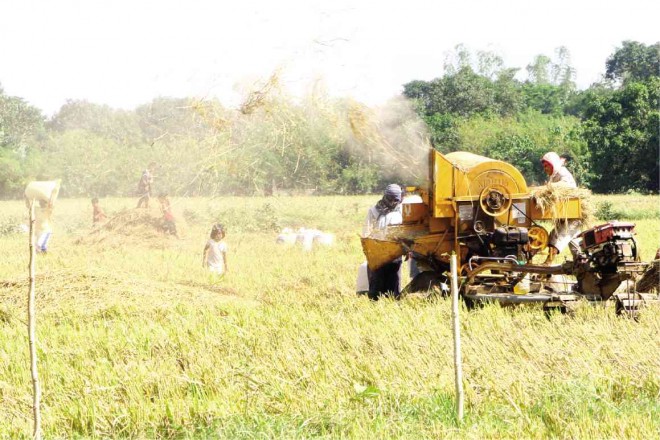Pangasinan traders sell rice at a loss

Farmers harvest and thresh palay on a farm in Rosales, Pangasinan province. Rice trading has become a losing venture in the eastern part of the province because prices have gone down since January this year. WILLIE LOMIBAO/INQUIRER NORTHERN LUZON
ROSALES, Pangasinan—Rice traders and millers from eastern Pangasinan are selling their stocks at a loss just to dispose of their warehouse supplies.
The market supply had been stable but rice prices had plunged way below the amount traders spent to buy their stocks, according to Ramon Cuaresma, National Food Authority (NFA) manager for eastern Pangasinan.
“They really have a problem,” Cuaresma said, because most traders and millers bought palay at P22 to P23.50 a kilo during the peak of harvest from September to December last year.
But prices plummeted to P18 to P19 per kilo in January.
“Even NFA is not meeting its distribution targets as the consumers prefer the commercial rice over NFA rice, although the quality is almost the same,” he said.
Article continues after this advertisementHe cited a rice mill owner from San Jacinto town, who has 200,000 bags of palay in his warehouse. “He is slowly selling even at losing prices just so he could turn the palay into cash,” he said.
Article continues after this advertisementAnother miller from Tayug town has more than 100,000 bags of palay.
Roger Tan, a rice mill owner from Rosales town, said there are more than 10 big millers and 30 small millers in eastern Pangasinan.
Big traders have warehouses that can store up to 1,000 bags while small traders have facilities that house up to 500 bags.
“We have 15,000 bags of palay which I bought at P22 to P23.50 a kilo. These now cost P19 a kilo. We are losing P3 to P4 each kilo,” Tan said.
“We should be selling milled rice at P2,000 per 50-kilo bag. But with the drop of prices, [sales are] down to P1,500 to P1,600 per bag,” he said.
He said some traders decided to wait a little longer for a slight increase in prices before they dispose of their stocks. “It’s up to fate. We just hope to recoup our capital,” he said.
But traders have another problem: Stocked palay has turned into “laon” (old grains). Fresh grains can last until six months.
Laon are grain stocks that are eight months old and would require more water when cooked. But consumers shun laon rice and prefer the newly harvested kind, so the prices drop further, Tan said.
Traders are also wary about the arrival of imported rice next month.
Cuaresma said shipments of NFA rice from Vietnam are scheduled to arrive on July 15, part of the 150,000 metric tons of rice from Vietnam and the 250,000 metric tons to be imported by NFA this year.
Cuaresma said he had not been informed as to how much volume would be allocated to Pangasinan, which has NFA offices in Binalonan town (with a stock of 140,000 bags as of June 11) and in Lingayen town (200,000 bags).
Because of the low market costs, however, private importers have adopted a wait-and-see attitude, Cuaresma said.
“Perhaps if they won’t lose, they would import. Otherwise, if the prices are higher abroad than the local prices and there is sufficient supply, they wouldn’t import,” he said.–Yolanda Sotelo, Inquirer Northern Luzon